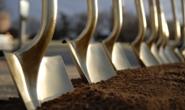Steel Markets

Housing Starts Fall in November
Written by Sandy Williams
December 16, 2016
Housing starts retreated in November to a seasonally adjusted annual rate of 1,090,000. The rate is 18.7 percent below the revised October estimate of 1.34 million and 6.9 percent below the November 2015 rate.
Sequentially, single family starts fell 4.1 percent and multifamily starts plunged 43.9 percent. On a year over year basis single family was down 6.9 percent and multifamily structure of five units or more fell 31.7 percent.
“Year-to-date, single-family starts are up 9.6 percent and the overall trend in this sector remains positive,” said Ed Brady, chairman of the National Association of Home Builders (NAHB) and a home builder and developer from Bloomington, Ill. “Builder sentiment is strong and we can look forward to growth in the single-family market in the year ahead as the industry adds workers and lots and Washington policymakers provide regulatory relief for small businesses.”
“Single-family starts declined from a robust level in October but still remain very solid,” said NAHB Chief Economist Robert Dietz. “Though rising mortgage rates could be a headwind for housing, we expect single-family production to continue on a long-run, gradual growth trend. Meanwhile, the multifamily sector, which has been volatile in recent months, is expected to level off at a solid rate as that market finds balance between supply and demand.”
Building permits, which are a predictor of future construction, were at a seasonally adjusted annual rate of 1.2 million, down 4.7 percent from the revised October rate of 1.26 million and down 6.6. percent year over year.
Single family permits increased by 0.5 percent while permits for structures with 5 or more units fell 15.8 percent from October. Year over year single family permits were up 5.9 percent and multi-unit dwellings down 26.4 percent.
Regional Statistics
Starts: Northeast -52.1 percent, Midwest -14.2 percent, South -9.3 percent and West -22.1 percent
Permits: Northeast -8.3 percent, South -4 percent, West -6.1 percent and Northeast a gain of 2.8 percent

Sandy Williams
Read more from Sandy WilliamsLatest in Steel Markets

CMC looks beyond Arizona micro-mill woes to long-term viability of construction mart
Despite the economic and geopolitical upheaval of the last five years, CMC President and CEO Peter Matt points out that the construction market has been an essential element of the way forward.

US importers face stricter rules under revamped S232 tariffs
“CBP expects full compliance from the trade community for accurate reporting and payment of the additional duties. CBP will take enforcement action on non-compliance," the agency said in a March 7 bulletin.

Steel exports rebound in January
US steel exports recovered to a five-month high in January after having fallen to a two-year low in December. This growth follows four consecutive months of declining exports.

Construction spending drops marginally in January
Construction spending edged down slightly in January, slipping for the first time in four months. The US Census Bureau estimated spending at a seasonally adjusted annual rate of $2,196 billion in January, down 0.2% from December’s downward revised rate. The January figure is 3.3% higher than a year ago. January’s result, despite the slight erosion, […]

HVAC equipment shipments slow in December but strong annually
Shipments of heating and cooling equipment in the US fell to an 11-month low in December, according to the latest data released by the Air-Conditioning, Heating, and Refrigeration Institute (AHRI).
